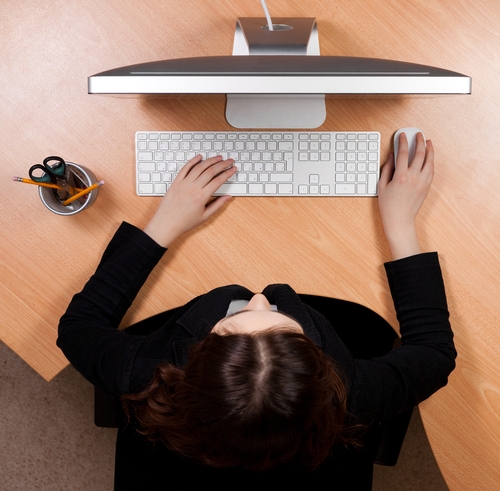Posted by: Clear Advantage in Uncategorized on February 9, 2015

Many of us use computers for many, if not all, of our work-related tasks. Constantly staring at a computer screen can cause eyestrain, which has become a major problem for many. Studies show that eyestrain occurs in 50 to 90 percent of those who use a computer for work.
Eyestrain can cause sore, itchy, tired eyes and can also result in headaches, sore neck and back, difficulty focusing, and sensitivity to light. While almost anyone can suffer from eyestrain, those who use a computer for several hours a day are at a higher risk of developing symptoms.
Ergonomics can help reduce the risk of eyestrain and ease many of its inconvenient and uncomfortable symptoms. Ergonomics is the study of people’s efficiency in their working environment. The goal of ergonomics is to create workspaces that properly fit people to help optimize their performance and reduce their risk of injury. While eyestrain is temporary and generally not serious, this type of visual impairment can often impair workers’ performance.
Here are a few easy ways to help reduce eyestrain using proper ergonomics.
- Be sure to sit up straight so that your head is in line with your torso and keep your head lifted upright, not bent down or tilted back.
- Sit with your shoulders square to your screen so you’re facing it directly without having to turn your head or twist your torso.
- Position your computer screen so that any windows in your office or work area are to the side rather than in front of or behind the screen. This will help minimize bright light that may cause eyestrain. Control natural light with shades, blinds, curtains, or window tinting and adjust the position of your screen to help reduce reflection from overhead lighting. You can also use an anti-glare screen filter.
- Make sure your computer screen is approximately 18 to 30 inches away from your eyes. Your screen should be close enough that you can read text easily without leaning forward. Looking at a screen that is too far away can cause you to strain your eyes to see small text while a screen that’s too close can make it difficult for your eyes to properly focus.
- Whenever you’re using printed documents in conjunction with your computer screen, use a document holder to keep those printed sheets in place. Place the document holder at the same height and distance as your computer screen to make it easier for your eyes to move back and forth from screen to print document.
- Be sure to follow the 20-20-20 Rule. After every 20 minutes of computer work, focus on an object 20 feet away for 20 seconds. Make sure to blink during this time as well. Take a more substantial break of 15 minutes or more for every two hours of moderate computer use or every hour for intense computer work.
- Schedule a comprehensive eye exam with your eye doctor. Almost 71% of people who report symptoms of computer eyestrain wear eyeglasses or contacts so it’s important to make sure that your prescription is correct and up to date. Tell your doctor about your workstation setup and the number of hours you spend each day on electronic devices and if you are experiencing symptoms of eyestrain so they can make the best treatment recommendations possible.






